- About Us
- Columns
- Letters
- Cartoons
- The Udder Limits
- Archives
- Ezy Reading Archive
- 2024 Cud Archives
- 2023 Cud Archives
- 2022 Cud Archives
- 2021 Cud Archives
- 2020 Cud Archives
- 2015-2019
- 2010-2014
- 2004-2009
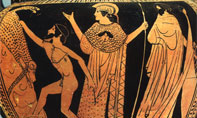 |
Immigration With a Difference |
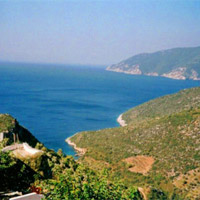
Today, when talking about or referring to immigrants we almost always mean people who, for economic, social, or political reasons, out of need or desire, but willingly, leave their homeland to settle temporarily or permanently in another country or place of residence. Their characteristic is that they are controlled insofar as their move is dictated by their circumstances and the need to move. However, they must not be confused with refugees who are forced by economic, political, religious or other reasons to move in order to survive and are fleeing persecution, repression, violence, deprivation and the threat of imprisonment or even death.
At the same time, though, there is another type of “immigrant”, those who are more aptly called “adventurers”. They are those individuals who, possessed by a restless but dynamic spirit, see immigration as an opportunity to fulfill their life ambitions. They are usually driven, not necessarily by need, but by the desire to explore new places which they consider exotic and exciting, acquire wealth by other than the ordinary ways, and meet different people, sometimes in a random manner.
The adventurer-immigrant typically is a male, young, having few if any responsibilities in terms of family, quite frequently a seaman, but definitely a major risk-taker. Of course, to a greater or lesser degree, all immigrants take risks, although the risk may be reduced by family or community support via chain migration, sponsorship, government programmes, etc.
As a result, a country like Greece, with national symbols and heroes like Odysseus and Jason and the Argonauts, being deep-rooted in its cultural tradition, folklore and literature, could not be without such “adventurers”.
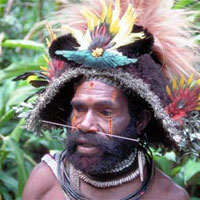 In this essay we focus on the latter case of “immigrants”, omitting, therefore, explorers, navigators, and the usual types of travelers or visitors to distant and exotic places.i For our purpose we shall consider two Greeks who spent years in the north of Australia’s regions of the south-west Pacific Rim, bringing to light their unconventional life stories – so different but at the same time so similar – and their daring enterprises which sometimes surpassed their human abilities, and in the end led them to failure, deep disappointment and even death.
In this essay we focus on the latter case of “immigrants”, omitting, therefore, explorers, navigators, and the usual types of travelers or visitors to distant and exotic places.i For our purpose we shall consider two Greeks who spent years in the north of Australia’s regions of the south-west Pacific Rim, bringing to light their unconventional life stories – so different but at the same time so similar – and their daring enterprises which sometimes surpassed their human abilities, and in the end led them to failure, deep disappointment and even death.
Adventurers in the regions north of Australia
Nicholas Minister
At Thursday Island on Australia’s northern frontier, at Cooktown and other Barrier Reef ports of Australia, even as far as Papua New Guinea’s ii chain of tropical islands such as the Trobriand Islands, D’ Estrecasteaux Islands, and the islands of the Luisiade Archipelago, many stories, even as late as the 1930s, were still told of reckless adventurers and buccaneers who constantly challenged their luck even to the point of death in these regions.
One such notorious and most picturesque character was Nicholas Minister, better known as “Nick the Greek”.
According to the [Lewis] Lett manuscript iii “the renowned Nicholas Minister – a Greek by birth- [was of] middle height, powerful, [with] oval face, pleasant resolute features, olive complexion and finely sparkling, hazel eyes”.
Indeed, Nicholas Minister was Greek. He was born on the Dodecanesean Island of Patmos in 1850 iv, a time when all the islands of this south-east Aegean Sea group were self-governed under the Turkish voccupation.
Coming from a poor and rather large family, with at least four sons that we know of (Nicholas himself, Peter, Mick and George), vi the only way to escape the poverty and hard times he and his family were experiencing, but also excited by the desire to make money and to see exotic places and meet different people, like so many other Greek islanders, Nicholas turned his sights and his hopes to the sea. Still a child, he left his rocky island to work on board a ship. Unfortunately, however, the first misfortune would hit him very soon. At the age of eleven he was shipwrecked off the shores of Italy, being the only crew member out of fourteen to survive. After this event, with his spirit undefeated and his physical strength intact, he worked on other ships. His determination to seek new experiences and reach distant and unusual destinations was not deterred. So, late in the 1870s we find him in Australia vii, ready to begin a new chapter in his adventurous life, full of successes and failures, far from his homeland which he would never see again.
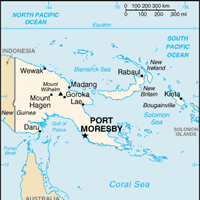 He made his way to Queensland and from there to the islands of the Torres Strait – Thursday Island, Hammond Island, Prince of Wales Island, etc. – north of Cape York between Australia’s northern peninsula and Papua New Guinea. First, he got closely involved with the Torres Strait islanders and was engaged in trade among the islands; then he became a prominent pearler and bêche-de-mer fisherman, leading, at the same time, an adventurous sea-faring life. This knowledge and his reputation spread throughout Queensland, southern Papua and the islands in-between. A result was his being hired as bosun on the Queensland government ship Pearl, under Captain Pennyfather “in which capacity he had had on more than one occasion to take part in the capture and punishment of both Australian and Papuan blacks and of whom it was said the natives of the Louisiade [Archipelago] were more frightened than of all the men-of-war of the British Navy” viii
He made his way to Queensland and from there to the islands of the Torres Strait – Thursday Island, Hammond Island, Prince of Wales Island, etc. – north of Cape York between Australia’s northern peninsula and Papua New Guinea. First, he got closely involved with the Torres Strait islanders and was engaged in trade among the islands; then he became a prominent pearler and bêche-de-mer fisherman, leading, at the same time, an adventurous sea-faring life. This knowledge and his reputation spread throughout Queensland, southern Papua and the islands in-between. A result was his being hired as bosun on the Queensland government ship Pearl, under Captain Pennyfather “in which capacity he had had on more than one occasion to take part in the capture and punishment of both Australian and Papuan blacks and of whom it was said the natives of the Louisiade [Archipelago] were more frightened than of all the men-of-war of the British Navy” viii
Indeed, already at the beginning of the 1880s, the Louisiade islanders got a bad taste of Nicholas Minister when he expanded his trading operations (especially the bêche-de-mer trade) to the islands of the Louisiade Archipelago, east of New Guinea, such as Paniet, Joanneh, Brooker, Sudest and Rossel, trading on his own account between them and the ports of Papua New Guinea (Port Moresby) and Queensland’s Cape York Peninsula (Cooktown). It was reputed that while doing his trading, he also got involved in deceivingly recruiting Louisiade islanders and sending them to work in the Queensland cane fields. Sometimes, though, the islanders would try to take revenge for his wrongdoings. One such case, perhaps his narrowest escape from death, was mentioned by an individual who argued that he was “much exposed over a period of years to the company and conversation of Nicholas the Greek”. This account was published in the Sydney journal The Bulletin (November 1928), although variations of the story appeared in other earlier and later issues of the same journal, as well as in other Australian journals, especially of Queensland, even in much later years.ix The unbelievable story is as follows: Minister was sailing to Milne Bay of East Cape to take his sick comrades ashore, when, after anchoring his cutter, a group of native islanders came out to his vessel and threw him overboard. Nicholas, thanks to his extraordinary courage and fighting ability which made up for his lack of height, got hold of a trailing rope and slowly managed to climb back on board via the bobstay. Battling his way he made a dash to his cabin where he drew the revolver he had in his sling bag, while blood was streaming down his face and shoulders from the numerous blows he sustained from the islanders’ long trade knives. Later, according to his own words, “it was just like shooting chickens”. Not one of the natives survived and Nicholas threw their bodies overboard to the sharks in the water below.
Many such adventures have been attributed to Nicholas Minister and tales could be written about this larger-than-life character, bêche-de-mer fisherman and buccaneer together, whose whole body from head to toe was covered by criss-cross and ridged scars, silent and permanent evidence of his desperate encounters with the islanders. His innumerable “man wounds” had been inflicted by spears, bullets, arrows, tomahawks, knives and even razors, though most were knife wounds. Actually, a contemporary who happened to know him well, wrote in the 1920s: “I never saw a man with such a mutilated hide as that Islands celebrity, the late lamented Nicholas the Greek”. According to the same informant, Nicholas used to confide, with that wary grin of his, that “man was the least formidable [adversary] because one always met him in his own element”. x
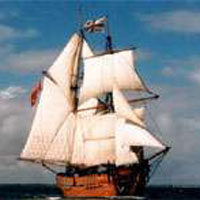 Nicholas Minister made a name for himself – some might say he created the material for a legend – with his fearless but also extremely vengeful character. An indicative example is the account of the retaliatory action he took against the Brooker islanders in 1884. After his vessel was seized by a group of these islanders with the intention to loot his cargo of trade goods and he was thrown into the sea, in his effort to climb back aboard, one of the assailants made a mess of his hands with a tomahawk. Despite the fact that he fell into the sea again and was thought to have drowned, the resourceful and unaided man, bleeding profusely from his hands, managed to jump on board. His appearance terrified the islanders so much, that believing it was his spirit which had returned, they jumped panic-stricken into the sea and swam to shore. According to Mollie Lett, a long-time resident of Papua, “the next morning the pigs of the ringleaders were shot, their canoes destroyed and their houses burned to the ground. The Brooker islanders left him in peace ever afterwards”.xi
Nicholas Minister made a name for himself – some might say he created the material for a legend – with his fearless but also extremely vengeful character. An indicative example is the account of the retaliatory action he took against the Brooker islanders in 1884. After his vessel was seized by a group of these islanders with the intention to loot his cargo of trade goods and he was thrown into the sea, in his effort to climb back aboard, one of the assailants made a mess of his hands with a tomahawk. Despite the fact that he fell into the sea again and was thought to have drowned, the resourceful and unaided man, bleeding profusely from his hands, managed to jump on board. His appearance terrified the islanders so much, that believing it was his spirit which had returned, they jumped panic-stricken into the sea and swam to shore. According to Mollie Lett, a long-time resident of Papua, “the next morning the pigs of the ringleaders were shot, their canoes destroyed and their houses burned to the ground. The Brooker islanders left him in peace ever afterwards”.xi
As the years were passing, though, Minister’s reputation, not only of his fearsome and adventurous nature but also of his excellent knowledge of the islanders and the water ways around Papua’s east end, was steadily growing. The Queensland authorities often took advantage of his expertise, as had happened in the past with his engagement as a boatswain of the Queensland government’s schooner, Pearl. This time, because of a long list of attacks against and massacres of traders, captains and their crews, including Australians, which were committed especially by the Louisiade islanders, during the years 1858-1887 xii retaliation measures were taken with Nicholas Minister’s help. Actually, in June 1885 Minister was recommended by Commissioner T. Bevan “to Admiral Tryon, H.M.S. Nelson, Sydney, as having the necessary knowledge and experience to help the warship capture the murderers of whites in the Lousiade islands”.xiii Bevan later would write that as early as 1883 he had suggested that Nicholas Minister, being a competent guide, should be absolutely necessary to accompany any punitive force. This suggestion was taken seriously and later, in January 1887, when the Queensland government assigned the Hon. John Douglas, as Special Commissioner to the Protectorate, to lead an expedition in order to arrest the ringleaders and bring the murderers to justice, he commisioned Minister as an advisor to help him catch them. Minister went along on that expedition, not failing to prove once again his tough way of administering justice, following his own motto: “Shoot first, enquire later”. One account of this mission informs us of how he went ashore Joanneh Island and through the forest approached a ringleader’s village, shot him, cut off his head and took it back to Governor Sir William MacGregor’s ship. He threw the chief’s head on the deck in front of the Governor and demanded the cash reward for it. Governor MacGregor ordered the head to be buried as “an end to that piece of disgrace”. xiv According to T. Bevan, eventually “the murder of unoffending Europeans has gone out of fashion as one of the fine arts of the natives of the Louisiades”xv
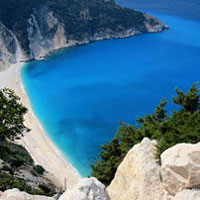 Of course, this rough pattern of behaviour should not surprise us. Just one year earlier the Sydney newspaper The Daily Telegraph had reported in an item entitled “News from New Guinea” that “Nicholas Minister, a notorious character, half bêche-de-mer fisherman and half buccaneer, against whom a charge of robbery and piracy on the high seas was lodged by Mr Kissach, Captain Thomson’s partner at Teste, as well as of kidnapping native women, has been required by the High Commissioner to proceed to Cooktown and meet his accusers there”.xvi Similarly, a missionary, Reverend Chalmers, protested officially about Minister’s acts succeeding in the latter being declared an outlaw.
Of course, this rough pattern of behaviour should not surprise us. Just one year earlier the Sydney newspaper The Daily Telegraph had reported in an item entitled “News from New Guinea” that “Nicholas Minister, a notorious character, half bêche-de-mer fisherman and half buccaneer, against whom a charge of robbery and piracy on the high seas was lodged by Mr Kissach, Captain Thomson’s partner at Teste, as well as of kidnapping native women, has been required by the High Commissioner to proceed to Cooktown and meet his accusers there”.xvi Similarly, a missionary, Reverend Chalmers, protested officially about Minister’s acts succeeding in the latter being declared an outlaw.
Although he was usually considered a ruffian and reckless – how much was true and how much was part of the tales that grew up around this “island legend” we will never know – “Nicholas the Greek” had some good deeds to his credit. For example, as an informant relates, on one occasion off the North Queensland coast as he was trying to rescue the life of a native girl, eleven islanders appeared before him brandishing tomahawks and knives. During the ensuing confrontation he was badly slashed before he managed to escape and reach shore through shark infested waters. As for his wounds he sewed them up with a packing needle and thread!xvii
Another story records that Minister, despite the kind of life he was leading and that he never revisited Greece, never forgot his Greek origin and identity. This is evidenced by the fact that in 1901 he donated £6 towards the building of Holy Trinity, the Greek Orthodox church in Sydney.xviii
What is fascinating about Minister’s life, however, is that apart from the volume of adventures – sometimes gruesome, sometimes thrilling – his life is also studded with some very humorous stories. The tale most frequently retold by the old-timers of North Queensland still in the 1930s, was how Minister eluded a cruiser off the New Guinea Coast.xix
The most amusing as well as most exaggerated version is in the January 1929 issue of The Bulletin. According to this account a Dutch cruiser was anxiously searching the waters of New Guinea for Nick to bring him to justice because he had caused some trouble in Dutch territory. The captain saw Nick’s cutter and inquired as to whether he knew the whereabouts of somebody called “Nicholas Minister”. Nick agreeably accepted to offer his services and piloted the cruiser through the dangerous reefs to parts of the coast where the rogue could be found. To the crews of the lowered boats Nick gave instructions on how to avoid the reefs and then proceed straight ahead. Nick then returned to his cutter, loaded with gifts and the captain’s expressions of thanks and went on his way. An hour later the boats were immobilised lying stranded on mud banks. The Dutch never found out that their helpful pilot was “Nick the Greek”, the man they were searching for.
In the years after his participation in the punitive expedition to the Louisiade Islands and the better conditions which gradually developed there with the natives, Nicholas Minister turned his interest again to pearling and trading, especially among the Trobriand and the D’ Entrecasteaux island groups. By 1890 “Nick the Greek” was working along business lines, and his pearl-fishing activities were flourishing without advertising or expensive offices in Australia or anywhere else. As his business was expanding and he needed more hands, he brought his three brothers (Peter, Mick and George) from Greece. By later recruiting even more Greeks, a Greek “colony” was said to have sprung up, especially in the Trobriands as well as on the D’Entrecasteaux.xx
So, the Greeks, with Nick, sporting his favourite Trobriand calico costume and as loquacious as ever, as their leader, quickly secured in their hands the pearl trade in this region and became as firmly established as their compatriots in the Sydney cray and oyster industries. The reputation of the Greek pearl trade spread beyond the region and overseas, and eventually their beautiful black, pink and yellow pearls attracted buyers from France and Germany to their trading posts on Samarai Island off the coast of east Papua as well as at the Trobriands.
After an extremely adventurous life of more than thirty years in Queensland, Papua New Guinea and the surrounding islands, on 18 January 1915, “Nick the Greek” died of dysentery, after three weeks of illness at the age of sixty-five, at his trading station at Teavi in the Trobriands. During his last years he continued to have his ups and downs and despite the several fortunes he had made and then lost, he left behind him an estate worth only £197.xxi What is more significant to us, however, is the legend he left behind. Nicholas Minister, who shared his life between pearl trading, bêche-de-mer fishing and sea roving, remains the most striking Greek adventurer of the Pacific Rim known to us – a Greek legend on the frontier north of Australia.
Mick George
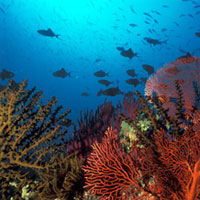 The tropical Melanesian islands (several of them low-lying coral atolls) of the Trobriand group, situated 190 kilometres directly north of the eastern tip of New Guinea xxii became a haven not only for Nick Minister but gradually for a number of other Greek adventurers and fortune seekers as well, who secured a hold especially on the lapi-lapi pearl trade in those waters of the south-west Pacific Ocean.
The tropical Melanesian islands (several of them low-lying coral atolls) of the Trobriand group, situated 190 kilometres directly north of the eastern tip of New Guinea xxii became a haven not only for Nick Minister but gradually for a number of other Greek adventurers and fortune seekers as well, who secured a hold especially on the lapi-lapi pearl trade in those waters of the south-west Pacific Ocean.
Among the Greeks of the trading “colony” which grew on the Trobriand island group, there was a trader by the name of Mick (Michael) George. Combining the information about the time Mick George lived and traded on the Trobriands, provided by the famous Polish anthropologist Bronislaw Malinowski xxiii in his in-depth studies on the Trobriand islanders and their way of life, with what we know regarding Nicholas Minister’s activities, we would not be surprised if we were led to the conclusion that Mick was one of Nicholas’ younger brothers, brought out from their native island of Patmos, to join Nick in his pearl trading enterprises.
Furthermore, if Mick George were one of Minister’s brothers, then it is quite probable that he joined him on the Trobriand Islands around 1890. By the end of 1917 (beginning of Malinowski’s second expedition), when Malinowski met Mick there, the latter had already spent about 27 years in the settlement of Kiriwina/Kiribi on the north end of the island of Boyowa xxiv, the main and largest island of the Trobriand group. xxv Extremely illuminating is Malinowski’s mention in this case of Mick, in his book A Diary in the Strict Sense of the Term xxvi which actually happens to be his first reference to him. Malinowski relates a congenial conversation he had with Mick on 10 November 1917 calling him “Mediterranean”, crouching like Achilles. He also refers to him as “a Greek trader long resident in the Trobriands”, mentioning Greek-Turkish cuisine and that Mick says one can “smell the bloody hotel two miles away”. In the same reference, Malinowski in a rather humorous vein cites one of Mick’s sentences (“Bloody German he no finish war”) in relation to the still raging World War I, labelling it as one of Mick’s “cosmopolitan ideas”, while at the same time it reveals to us Mick’s poor knowledge of English.
Beyond all this, however, Malinowski admits in the same reference that he liked Mick, that he frequently stayed in his home when he was on the island of Boyowa, and he acknowledges that Mick, who was middle-aged by that time, helped him as an informal source with his ethnographic studies, in particular with the language and the customs of the Trobriand islanders. After all, Mick was well acquainted with them after his many years of residence in their social environment. Of course, Mick George did not miss the opportunity to talk to Malinowski about his countrymen and his island home. Malinowski’s often-mentioned deep appreciation of the invaluable assistance and hospitality he was offered by Mick George and the other pearl traders and buyers of the Trobriand Islands, however, is clearly attested even in the acknowledgements of his book Argonauts of the Western Pacific, which he published about two years after his 1914-1920 three ethnographic fieldwork expeditions. Among the other traders he singles out Mick George: “Other pearl traders and buyers of the Trobriands were also very kind to me, especially … and the late Mr. Mick George, all of whom helped me in various ways and extended to me their kind hospitality”.xxvii
In reality, Mick George was a trader in pearls, pearl shell, copra xxviii and other goods, such as tobacco and benzine, confronting the tough competition among the traders who tried to take advantage of one another, especially in trading pearls. He had been in the Trobriand Islands, and especially at the settlement of Kiriwina (he ran a trading shop there) on the main island of Boyowa, for several years before the Commonwealth Government of Australia took the whole area over from Great Britain in 1905 and the time when Malinowski arrived there in 1914.
Mick was generally regarded as having a hospitable manner and outgoing personality, and he appeared to have been liked by the islanders as well as visitors. However, he fought against the indigenous people and became an absolute master in his treatment of them, so that after the Australian Government assumed control of south-eastern New Guinea and the nearby surrounding island groups as the Territory of Papua, Mick was threatened with capital punishment. Malinowski hints that Mick disliked missionaries and government officers. xxix It is easy to understand why he would have considered them a threat.
Nevertheless, in the reckless and adventurous life he led, Mick also made a somewhat valuable contribution to communal life in the Trobriands, although it was always within the frame of money-making. He introduced the European type of pig for which the islanders coined a new word to describe it, bulukwa Miki meaning “Mick’s pig”. These pigs were valued highly, that is one would bring five to ten native pigs in exchange.xxx Malinowski also suggests in his diary that Mick considered the islanders to be uncivilised and rather impractical as they allowed his pigs to interbreed with their inferior ones.xxxi Mick also voiced his dislike of some of the natives’ ways, such as cooking live pigs.
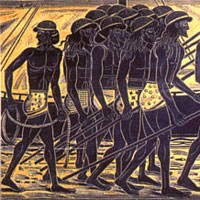 Finally, Malinowski remembers that on a visit to Kiriwina in December 1917, he found Mick very unwell, coughing horribly.xxxii It was obvious that luck had started deserting Mick and the symptoms described by Malinowski indicate Mick may have been suffering from the last stages of tuberculosis – the disease that would plague Malinowski as well until his death in 1942. For in February 1918, after Malinowski went for another visit to Kiriwina in a dinghy, he met Mick looking a melancholy sight “sitting there, wasting away, watching the gray lagoon”.xxxiii Malinowski also noticed that Mick’s house was empty and that he was squatting with a towel in hand on the crumbling veranda, obviously quite ill and very lonely. From Malinowski’s references to Mick’s coughing and colour, it appears that he might also have had malaria in addition to tuberculosis. It was already apparent that the end was rapidly approaching.
Finally, Malinowski remembers that on a visit to Kiriwina in December 1917, he found Mick very unwell, coughing horribly.xxxii It was obvious that luck had started deserting Mick and the symptoms described by Malinowski indicate Mick may have been suffering from the last stages of tuberculosis – the disease that would plague Malinowski as well until his death in 1942. For in February 1918, after Malinowski went for another visit to Kiriwina in a dinghy, he met Mick looking a melancholy sight “sitting there, wasting away, watching the gray lagoon”.xxxiii Malinowski also noticed that Mick’s house was empty and that he was squatting with a towel in hand on the crumbling veranda, obviously quite ill and very lonely. From Malinowski’s references to Mick’s coughing and colour, it appears that he might also have had malaria in addition to tuberculosis. It was already apparent that the end was rapidly approaching.
Mick did not manage to live beyond 1918. He breathed his last on the Trobriand Island of Boyowa, four years after Nick Minister’s death in the same island group.
Mick had been lured by the idea of making a fortune in an unknown and distant foreign land. He ended up alone, almost penniless, and destroyed by disease – not an unusual story, however, in the world of most fortune hunters attempting the impossible by reckless means.
Conclusion
These two Greek adventurers, Nicholas Minister and Mick George, despite their differences, had many resemblances between them. Both of them were daring and crafty; they both considered the south-west Pacific rim as the area where they could harvest their fortunes. Unscrupulous and brutal, they differed more in degree than in kind. Both of them had an unbridled hunger for wealth, not glory or anything else, and both concentrated their energies to survival in unconventional and often unlawful ways at any cost. Unfortunately, they overestimated their abilities and finally their life adventures turned into failure. Some might say they ran out of luck.
Nicholas Minister and Mick George are only two, and perhaps not the most inspiring examples, of the many Greek adventurers and fortune hunters who, driven by their life circumstances or the Argonautic spirit, sought a place in the remote south-west Pacific rim as a base for their bold and imaginative enterprises.
Their turbulent lives, however, are fascinating subjects for both the scholar and the general reader. Sometimes they are also frustrating and unrewarding subjects when evidence for their lives is incomplete or the stories of their activities conflict. It would not be surprising if research unearthed more Greeks of this type in the Pacific rim north of Australia – though not necessarily rogues and scoundrels like Mick George and Nicholas Minister – but more like Constantine Gerakis (Constant Phaulkon (1647-1688) who, born in Cefallonia and after a frenetically eventful life, rose to become Prime Minister of Siam (now Thailand) in the north-west Pacific, while others, like shooting stars have disappeared leaving no traces or remembrances behind them. Definitely more scholarly research is waiting for us, challenging our interest and our imagination.
ENDNOTES:
iFor Greek explorers and discoverers, see Ch. D. Lazos, Greeks in the Discovery and Exploration of America, Athens: Aeolos, 1990. [In Greek, with interesting bibliography.]
ii Papua New Guinea is an independent nation in the Pacific Ocean’s Melanesian island group, north of Australia. It consists of the eastern half of the island of New Guinea and a chain of tropical islands which extend more than 1,600 kilometres: the Bismarck Archipelago, Bougainville and Buka in the Solomon Islands chain, the Trobriand Islands, the D’ Entrecasteaux Islands, the Louisiade Archipelago and Woodlark Island. Papua New Guinea has a total area of 178,704 square kilometres and a population of about 3,405,000. The first explorers to land on the islands were Spanish and Portuguese in the early 1500s. In 1905 south-eastern New Guinea as well as the islands mentioned above were given to Australia by Great Britain and named the Territory of Papua. In 1920 the League of Nations officially put these areas under Australian administration, and on September 16, 1975 they became independent as the nation of Papua New Guinea. See also The World Book Encyclopedia, Vol. 15, Chicago: World Book, Inc., 1985, p. 8a, 119, 121.
iii MS: National Library of Australia (Canberra), 2039, folder 25, p. 1r, This manuscript consists of 10 pages not in complete condition (p. 2v illegible, except for Notes, Nicholas the Greek, Nicholas the Greek and old New Sumea Massacres and traders 1883-4-5; p. 4v only a small part of handwritten page remains (7 lines), text irrelevant; p. 10v illegible, except for Notes re Nicholas Minister and Massacres before and after Protectorate 1884). It comprises part of the (Lewis) Lett papers held by the Library.
iv Hugh Gilchrist, Australians and Greek, Volume I: The Early Years, Sydney: Halstead Press, 1992, p. 114. To the contrary, H.J. Gibbney and Ann G. Smith, compilers and editors of A Biographical Register 1788-1939 (Vol. II, L-Z, Canberra: The Australian Dictionary of Biography, 1987, p. 107, col. 2), provide c. 1863 as Minister’s birth year. My calculations, though, based on these two, as well as other sources, lead me to agree with Gilchrist.
v The islands of the Dodecanese rejoined the Greek state after World War II in 1948.
vi Frank Reid, “Torres Strait Adventurers”, Northern Affairs: A Monthly Journal of far Northern Concerns (Cairns), Vol. 1, No. 4 (7 August 1931): 5.
vii Gilchrist, 1992, p. 114.
viii Regarding this information see the Lett manuscript, which in turn, according to a note by its writer was derived from a book (no title given) by T. Bevan, an Australian Commissioner and recommended minister. For Nicholas Minister’s engagement in the Queensland government ship under Captain Pennyfeather, see also H.J. Gibbney and Ann G. Smith, comps and eds, 1987, p. 107.
ix The individual who published the story about Minister in the November 28, 1928 issue of The Bulletin (p. 12) is mentioned under the pen name “Kiriwina”. Basically, the reason he published the short message was to correct the erroneous pieces of information which had slipped into the story with the passage of time. For this story, among other sources, see also Frank Reid, 1931, p.5.
x “Gouger”, The Bulletin (Sydney), 7 November 1928, p. 12.
xi See the reference in Gilchrist, 1992, p. 116.
xii In November 1884 Great Britain took over from Germany the south-eastern part of New Guinea, as well as the nearby islands, and declared them a Protectorate. See also The World Book Encyclopedia, Vol. 15, 1985, p. 121.
xiii (Lewis) Lett manuscript, [p. 8].
xiv R.B. Joyce, Sir William MacGregor, Melbourne: Oxford University Press, 1971, p. 129, 407 fn. 27; Gilchrist, 1992, p. 116.
xv (Lewis) Lett manuscript, [p. 8].
xvi “News from New Guinea”, The Daily Telegraph, 9 July 1886, p. 5.
xvii “Gouger”, p. 12.
xviii Gilchrist, 1992, p. 117.
xix This story was told so many times during the years which passed that finally it ended up with a number of variations. Cf. the story by “McNorth” <sic> in The Bulletin of 1916 (23 March, p. 14) which mentions a “patrolling warship” without specifying its nationality with that in The Bulletin of 1929 by “Questo” <sic> (2 January, p. 19) which talks about a Dutch cruiser and with Hugh Gilchrist’s account (1992, p. 115) of a French warship.
xx “Bouragi”, The Bulletin, 5 August 1920, p. 34; Frank Reid, 1931, p. 5.
xxi Reid, 1931, p. 5.
xxii The first known European visitor to the Trobriand islands south of the Equator was the French vessel Espérance in 1793. Those islands were named by the French navigator Bruni d’Entrecasteaux after his lieutenant, Denis de Trobriand. The waters around the islands were soon filled with ships from all over Europe. American whaling ships made frequent stops there, as did German ones, which were in search of yams, the tropical vines which are grown for their edible starchy tubers and their roots, especially in South-East Asia and West Africa. Since 1975, politically, they belong to the nation of Papua New Guinea. (See also http://www.janesoceania.com/ trobriands_online/index.htm and http://en.wikipedia.org/wiki/Trobriand_Islands.)
xxiii Bronislaw Kasper Malinowski (1894-1942) advanced the study of cultural anthropology beyond its descriptive stage (actually considered one of the founders of modern social anthropology) and initiated the so-called functional school of anthropology. In 1914 he joined the Robert Mond Expedition to New Guinea and north-west Melanesia, and in early September, via Brisbane (Queensland, Australia) he went to Papua (Port Moresby area and the nearby Mailu area in the south of New Guinea) and the Trobriand Islands to do fieldwork on the indigenous people. This expedition lasted for one year until August 1915. Two years later, Malinowski, this time via Sydney, conducted an expedition mainly to the Trobriand Islands lasting about nine months (end October 1917 – mid-July 1918). It is worth noting in our case that Australia and its Aboriginal people were also in Malinowski’s centre of anthropological interest. He travelled to Australia with the British Association and under it or alone he visited various places (Sydney, Toowoomba, Brisbane, Melbourne, Adelaide and elsewhere), establishing even a circle in Melbourne. Malinowski’s early research interest on the Aborigines of Australia is proved by the fact that his first major published work was about them (The Family among the Australian Aborigines, London: University of London Press, 1913), while other studies were published there, such as the report on his 1914-1915 expedition (“The Natives of Mailu: Preliminary Results of the Robert Mond Research Work in British New Guinea”) which was included in the Adelaide scholarly journal Transactions of the Royal Society of South Australia for 1915 (p. 494-706).
xxiv The islanders called themselves Boyowans, while their language which is also the language of the Trobriand islanders in general, is known as Kiriwina or Kiriwinian, from the name of the main island. It constitutes part of the Milne Bay Group of Austronesian, or Malayo-Polynesian, family of languages and is closely related to the languages spoken on the neighbouring Woodlarks, Marshall Bennets and Laughling islands. It is also related to the languages of eastern Papua (See Carl F. Voegelin, “Languages of the World: Indo-Pacific Fascicle Three”, in Carl F. Voegelin and Florence M. Voegelin, Anthropological Linguistics, 6, Bloomington: Indiana University, 1964, p. 1-11. In general, for the Austronesian languages see mainly Ross Clark’s introduction to Austronesian Languages, in Bernard Comrie, ed., The World’s Major Languages, London: Croom Helm, 1987, p. 901-912 and Kenneth Katzner, The Languages of the World, London: Routledge ( of the Taylor and Francis Group), 2002, p. 23-24.
xxv Malinowski refers to Mick George mainly in two of his works: In his monograph Argonauts of the Western Pacific: An Account of Native Enterprise and Adventure in the Archipelagoes of Melanesian New Guinea (London: Routledge and Kegan Paul, Ltd., 1922 with several impressions to its credit) and, abundantly, in his work A Diary in the Strict Sense of the Term (Stanford, USA: Stanford University Press, 1989 [Originally published in London by Routledge and Kegan Paul, 1967 and translated into English by Norbert Guterman]). There should be mentioned that this diary includes the content of two envelopes with notebooks (one marked “Early Polish Diary” and the other “Diaries”), all hand written in Polish with frequent use of English, words and phrases in Greek, Latin, German, French and Spanish, as well as terms from the indigenous languages. These diaries were never intended for publication until 1960 when his second wife, Valetta Malinowska, decided on their publication. In addition, according to a remark by Mario Bick, the compiler of the index of the native terms included in the book, Malinowski “seems to have used four languages in his field work: Motu in the Port Moresby and Mailu areas, Mailu, Kiriwinian and pidgin.
xxvi Malinowski, 1989, p. 146-147.
xxvii Malinowski, 1922, p. xix-xx.
xxviii This word first appeared in the late 16th century. It is a Portuguese and Spanish term from Malayalam koppara. It means dried coconut kernels from which oil is obtained.
xxix Malinowski, 1989, p. 212.
xxx Ibid., 1967, p. 307. See also relevant reference in his book The Father in Primitive Psychology, London: Kegan Paul and Co., 1927, p. 65, 66.
xxxi Malinowski, 1927, p. 65, 66.
xxxii Malinowski, 1989, p. 171.
xxxiii Malinowski, 1989, p. 211.
BIBLIOGRAPHY
Books - Articles
“Bouragi”, The Bulletin (Sydney), 5 August 1920, p. 34.
Clark, Ross, “Introduction” (Austronesian Languages), in Bernard Comrie, ed., The World’s Major Languages, London: Croom Helm, 1987, p. 901-912.
Gilchrist, Hugh, Australians and Greeks, 3 vols., Sydney: Halstead Press (Vol. I, The Early Years, 1992; Vol. II, The Middle Years, 1997; Vol. III, The Later Years, 2004).
“Gouger”, The Bulletin (Sydney), 7 November 1928, p. 12.
Joyce, R.B., Sir William MacGregor, Melbourne: Oxford University Press, 1971.
Katzner, Kenneth, The Languages of the World, London: Routledge (of the Taylor and Francis Group), 2002.
“Kiriwina”, The Bulletin (Sydney), 28 November 1928, p. 12.
Lazos, Ch. D., Greeks in the Discovery and Exploration of America, Athens: Aeolos, 1990 [In Greek].
Malinowski, Bronislaw, The Family among the Australian Aborigines, London: University of London Press, 1913.
Malinowski, Bronislaw, “The Natives of Mailu: Preliminary Results of the Robert Mond Research Work in British New Guinea”, Transactions of the Royal Society of South Australia for 1915 (Adelaide), [1915]: 494-706.
Malinowski, Bronislaw, Argonauts of the Western Pacific: An Account of Native Enterprise and Adventure in the Archipelagoes of Melanesian New Guinea (London: Routledge and Kegan Paul, Ltd., 1922.
Malinowski, Bronislaw, The Father in Primitive Psychology, London: Kegan Paul and Co., 1927.
Malinowski, Bronislaw, A Diary in the Strict Sense of the Term, Stanford, USA: Stanford University Press, 1989 [Originally published in London by Routledge and Kegan Paul, 1967].
“McNorth”, The Bulletin (Sydney), 23 March 1916, p. 14.
“News from New Guinea”, The Daily Telegraph, 9 July 1886, p. 5.
“Questo”, The Bulletin (Sydney), 2 January 1929, p. 19.
Reid, Frank, “Torres Strait Adventurers”, Northern Affairs: A Monthly Journal of far Northern Concerns (Cairns), Vol. 1, No. 4 (7 August 1931): 5.
Voegelin, Carl F., “Languages of the World: Indo-Pacific Fascicle Three”, in Carl F. Voegelin and Florence M. Voegelin, Anthropological Linguistics, Bloomington: Indiana University, 6, 1964, 1-11.
Dictionaries – Encyclopedias
Brown, Lesley, ed. The New Shorter English Dictionary on Historical Principles, 2 vols., Oxford: Clarendon Press, 19934.
Gibbney, H.J. and Ann G. Smith, comps and eds, A Biographical Register 1788-1939, 2 vols. , Canberra: The Australian Dictionary of Biography, 1987.
Hofmann, J.B., Etymologisches Wörterbuch Des Griechischen, München: Verlag Von R. Oldenbourg, 1950 [In Greek, 1989].
Klein, Ernest, A Comprehensive Etymological Dictionary of the English Language, Amsterdam: Elsevier Scientific Publishing Company, 1971.
The World Book Encyclopedia, 24 vols., Chicago: World Book, Inc., 1985.
Manuscript
MS: National Library of Australia (Canberra), 2039, folder 25, pages 10 [The manuscript is incomplete and comprises part of the (Lewis) Lett papers].
Electronic Sources
http://en.wikipedia.org/wiki/Trobriand_Islands
http://www.janesoceania.com/ trobriands_online/index.htm
Dr. George Kanarakis is an Adjunct Professor at Charles Sturt University in Bathurst
